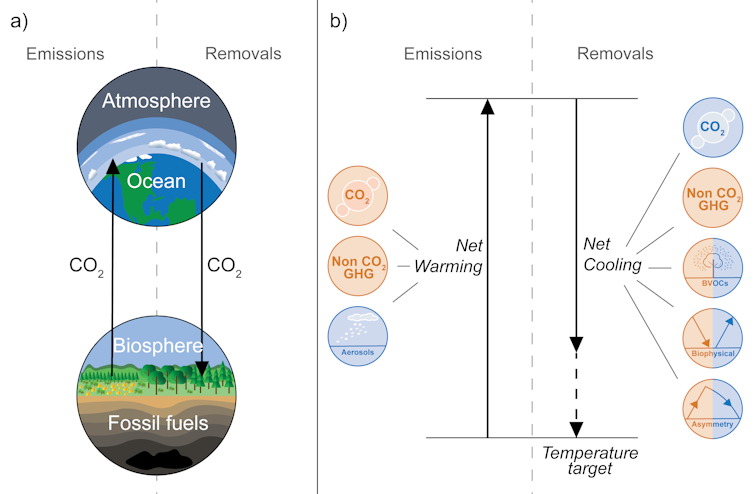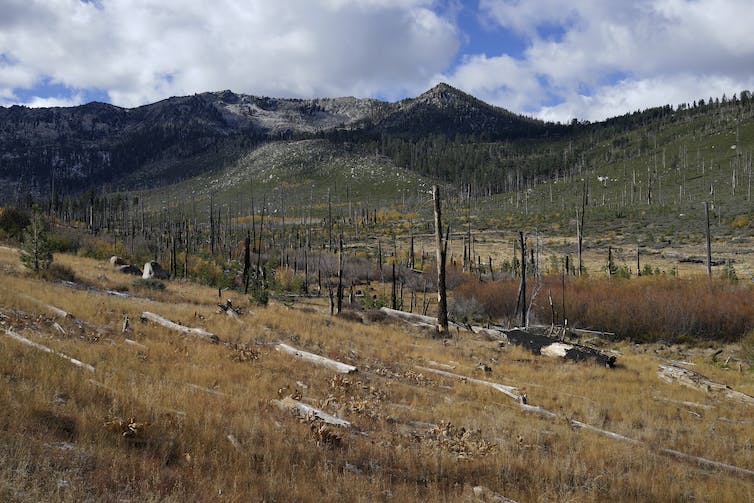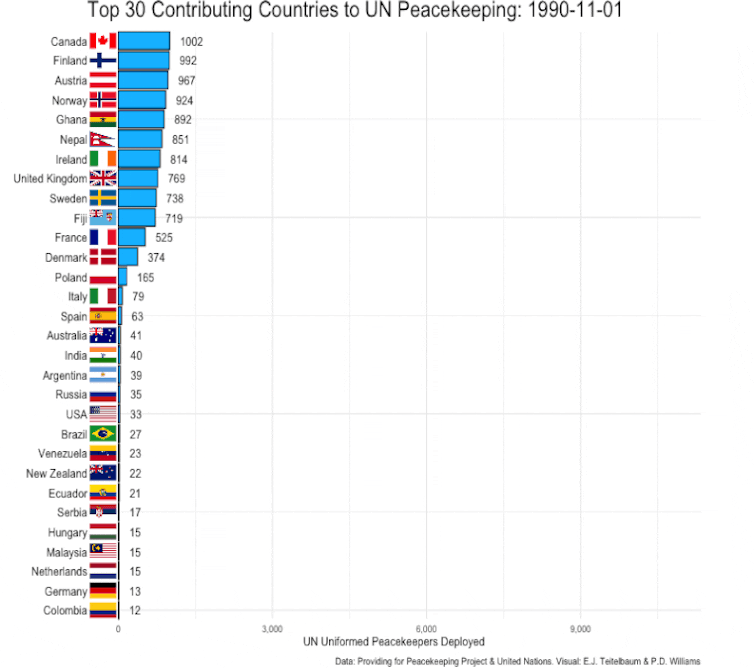As delegates gather in Dubai at the COP28 climate conference — with the aim to ratchet up ambition towards meeting the goals of the Paris Agreement — a key component of these efforts are countries’ pledges to achieve net-zero emissions around mid-century.
Net-zero carbon dioxide (CO₂) emissions refers to a balance between CO₂ emissions into the atmosphere and CO₂ removals from the atmosphere, such that the net effect on CO₂ levels in the atmosphere is zero. It is often assumed that if such a balance is achieved, the net effect on climate would also be zero.
COP28 climate summit just approved a ‘loss and damage’ fund. What does this mean?
However, in a recent paper in Nature Climate Change, we show that unless we consider a number of other factors — such as permanence of carbon stored in vegetation and soils, changes in the reflectivity of landscapes and the full suite of greenhouse gases emitted — balancing CO₂ emissions with removals will not achieve the intended climate goal.
Carbon dioxide removal (CDR) refers to human activities that deliberately remove carbon dioxide (CO₂) from the atmosphere. CDR can leverage either natural or technological systems, though in either case, it must be additional to the CO₂ removal that is driven by passive carbon sinks already at work, such as existing forests.
Examples of CDR include planting trees on previously deforested or unforested lands, producing bio-energy and capturing and storing the emitted carbon, fertilizing the ocean to stimulate biological production and capturing CO₂ directly from the air through chemical and technological means.
What are the potential problems?
For CDR to balance the climate effects of CO₂ emissions from fossil fuel burning, it needs to result in permanent carbon storage, meaning that the carbon must remain undisturbed for centuries to millennia. However, carbon stored in trees is vulnerable to natural disturbances such as droughts, wildfires, insect outbreaks and other biotic disturbances and could be re-released much sooner.
Carbon sequestered and stored in seagrass meadows or mangrove forests, for example, is re-released following marine heat waves. Any reversals in land-use and management decisions can also affect the permanence of carbon stored by CDR.
(AP Photo/Brian Melley)
Several CDR approaches, when deployed at a large-scale, affect fluxes of energy and water at the Earth’s surface, resulting in so-called “biogeophysical” effects on climate that are in addition to the effects of CO₂ sequestration.
For example, large-scale planting of trees in agricultural areas or grasslands results in a reduction of how well the land surface is able to reflect sunlight, and therefore leading to a warming effect. This effect is particularly strong in regions with seasonal snow cover, where the darker colour of trees reduces the high reflectivity of snow.
Deployment of a range of CDR methods can also result in increased emissions of nitrous oxide and methane, two powerful greenhouse gases. For instance, bio-energy with carbon capture and storage and reforestation require the use of nitrogen fertilizers, which enhances nitrous oxide emissions.
Restoration of coastal ecosystems, such as seagrass meadows or mangrove forests, can also result in an increase in methane and nitrous oxide emissions.
Geoengineering sounds like a quick climate fix, but without more research and guardrails, it’s a costly gamble − with potentially harmful results
Because of the potential impermanence of carbon stored by CDR, and biogeophysical and other greenhouse gas effects, balancing emissions of CO₂ with CDR might not always result in the intended climate outcome.
For example, balancing fossil-fuel emissions with CO₂ removal through large-scale reforestation can result in a higher global warming compared to a case where the fossil fuel emissions are eliminated. This asymmetry could lead to exceeding temperature limits set by the Paris Agreement.
What to do about it?
For the reasons above, greenhouse gas accounting, and policies designed to offset greenhouse gas emissions, need to consider the full suite of climate effects of the proposed CDR to ensure intended climate goals are not compromised.
CDR approaches with short carbon storage time scales, or at high risk of natural and/or anthropogenic disturbance (like in fire-prone regions), should not be used to balance fossil-fuel CO₂ emissions.
For carbon removal that targets carbon stores at lower risks of disturbance, it is crucial that net-zero protocols also require an excess amount of CDR as an insurance in the event of carbon losses.

(Kirsten Zickfeld), Author provided (no reuse)
Similarly, CDR approaches that result in biogeophysical effects or release gases such as methane and nitrous oxide upon deployment risk fully negating the climate benefit of carbon sequestration and should be excluded as a means of balancing fossil-fuel CO₂ emissions.
In cases where biogeophysical effects or the release of GHGs partly counter the climate benefit of carbon sequestration, an additional amount of CDR is also required to compensate these effects. The measures used to establish equivalency between CO₂ emissions and removals, and biogeophysical and GHG effects, need to be rigorous and grounded in science.
Emissions reductions remain primary
Nature-based climate solutions that are not suitable for balancing fossil-fuel emissions because of a high risk of carbon losses — and/or large biophysical or GHG effects — may still be appropriate to deploy because of benefits other than climate change mitigation. That includes preserving or restoring biodiversity and increasing the resilience of landscapes.
If deployed in addition rather than as an alternative to fossil-fuel emission reductions, these solutions can still have climate benefits, even if relatively temporary.
COP28: How 7 policies could help save a billion lives by 2100
Carbon dioxide removal will be needed to balance emissions that are difficult to eliminate and increase the odds of meeting the Paris Agreement climate goal.
However, while CDR can play a crucial role in climate change mitigation, the current uncertainty around its full effects underscores the need to prioritize reducing emissions as rapidly and as much as possible.




